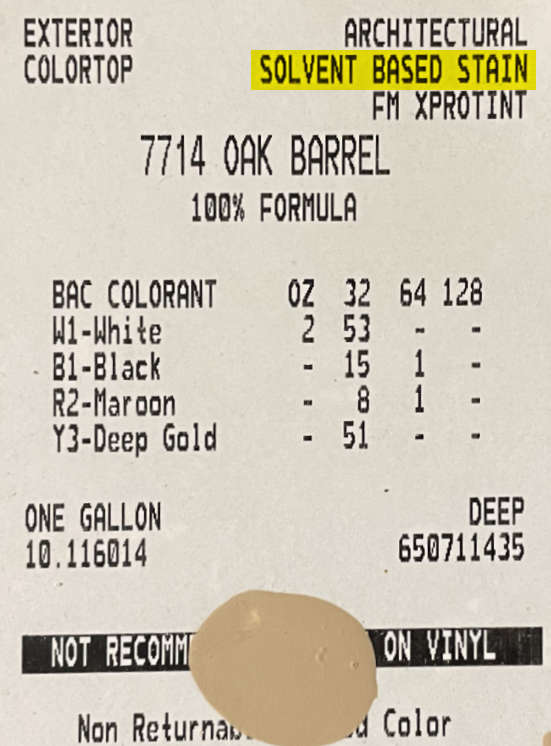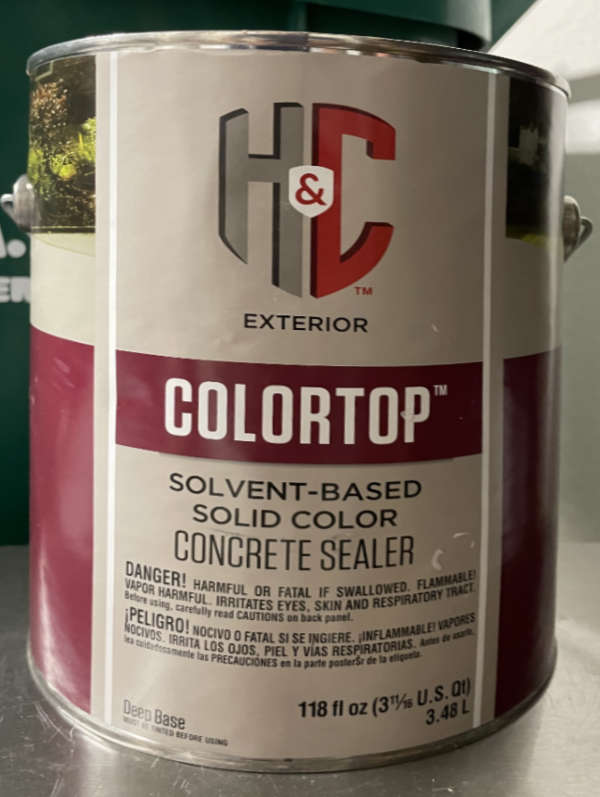*This is the exciting sequel to this post, neither of which really had anything to do with fine print, but we’re all about artificial drama here at the Gazette. Oh, and it’s also probably not that exciting, but we’re also all about hyperbole.
Unfortunately, we’re not all about reading labels.

We recently completed a project wherein almost all of our exterior surfaces were repainted. OK, by “we” I mean somebody who knew what they were doing. Also, the exterior surfaces in question are on our house, not on our, you know, bodies. Mostly. Therein lies part of the tale.
Most of the house’s stucco and all of its wood trim were repainted, and the pergola was stained and clear-coated to match our deck. They also repainted our metal garage doors and painted the narrow concrete “apron” that fronts each garage door. Everything looks nice and fresh and clean, and we’re very pleased with the job the painting crew did (if you live in our area and want a referral, feel free to contact me).
There were, however, two very small areas that needed touch-up paint, neither of which were the responsibility of the painters.
The first was a tiny spot above our doorbell. The previous (and original) owners of the house had installed a twee butterfly cover over the doorbell button, with the result that no one recognized it as a doorbell. Who knows…that might have been their intention all along. But we got tired of people banging on the front door instead of ringing the doorbell, even though we can’t hear it most of the time. So…where was I? Oh, yeah…so, I replaced that cute-but-ineffective device with a nice, lighted, doorbell-looking button. Doing so, however, revealed the aforementioned tiny spot that needed repainting. It bugged Debbie every time she saw it; I was pretty much oblivious to it, but I obviously and sadly misjudged the extreme egregiousness of this sad and obvious situation.
The other area was a somewhat larger patch of stucco that was revealed when the old gutters were taken down (as I write this, the crew is at work installing new gutters). Now, this one I could definitely recognize, and even though it would be obscured by the new gutters, I accepted the mandate to address it in a painterly fashion.
The painters had left a can of paint in the color we needed for the stucco (Sherwin-Williams “7714 Oak Barrel,” an enchanting mixture of white, black, maroon, and deep gold…resulting in a color that looks, well, beige to my color-challenged eyesight) on a flowerbed border, and I put a note on it to notify them that we wanted the leftover paint, which of course they were going to give us anyway, thereby increasing our seven year old collection of old paint that we don’t know how to dispose of nor have a use for.
I waited until they had wrapped things up so they wouldn’t laugh at my inevitably amateurish approach, and then I opened the can of paint and stirred it, while noting that it seemed a little thinner than what I expected. But the color was right, and the two areas matched the surrounding paint perfectly when I finished the five minute job.
I wiped the excess paint from the brush and took it to the laundry room sink to finish the cleanup with soap and water. But something odd happened…the more I rubbed on the brush bristles, the more the paint adhered to, well, everything, including my hands. I tried more soap, and that had no effect whatsoever. I managed to spread paint from fingertip to wrist on one hand, as well as on the faucet and all over the stainless steel sink. This was not the behavior I expected from exterior latex house paint.
I went back to the garage to use some of that orange industrial strength hand cleaner that I keep under the illusion that I’m qualified to do manual labor, and the paint on my hands simply laughed in a mocking fashion at that futile attempt. That’s when I had the bright idea of looking at the paint can, and for the first time, I read more of the label than just the name of the color.

Below: The paint type is printed below in gray, possibly Grizzle Gray (SW 7068)

Yep. What I failed to notice was that the paint was not latex after all. It was the solvent-based — aka, oil-based — concrete sealer that they had used to paint the concrete apron in front of the garage doors. And while I don’t know much about paint, I do know that such paint cannot be cleaned up with soap and water. In reality — and this is a little-known fact that I just made up — attempting to clean it with water has the same effect on the paint that water had on those pesky Gremlins, and we all know how that turned out.
I should have put a pause on things when I first opened the can and noticed the relative thinness of the paint. Both oil-based and water-based paints are partially composed of solvent. In the former, it’s an organic or hydrocarbon compound that’s a proportionately higher percentage of the product than the water that’s used as a solvent in the latter type of paint. Solvents in both types evaporate which causes the pigment and the binding agent to solidify to form the hard color surface. The organic solvents evaporate much quicker than water, so oil-based paints dry faster and form a harder “shell” than the water based counterparts. They also have a much stronger odor.
Fortunately, I keep a can of mineral spirits around for situations like this. Just kidding. I have no idea why I have a can of mineral spirits. But it came in handy and I was able to more-or-less clean the sink and the portion of the skin on my hands that was still present, post-scrubbing. The paintbrush, bless its heart, was a total loss; it served us faithfully, and it will be difficult to replace, at least until I find another $1.12 in our couch cushions.
Despite this fiasco, the touchuped…touchup’d…repainted areas look good, and isn’t that really what it’s all about: the destination, not the journey?
I did learn a valuable lesson or two, and as soon as my head clears from the mineral spirits fumes, I’ll try to remember to share it here. I think it has something to do with Asian land wars…
Discover more from The Fire Ant Gazette
Subscribe to get the latest posts sent to your email.

